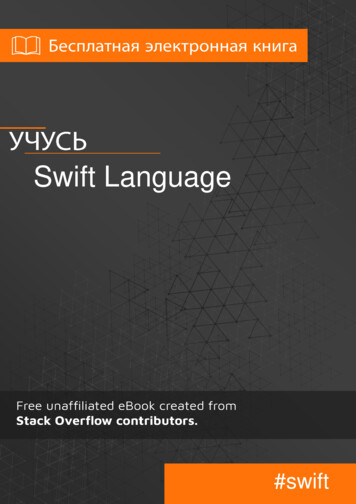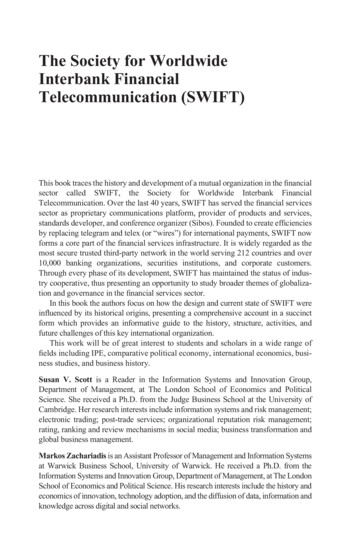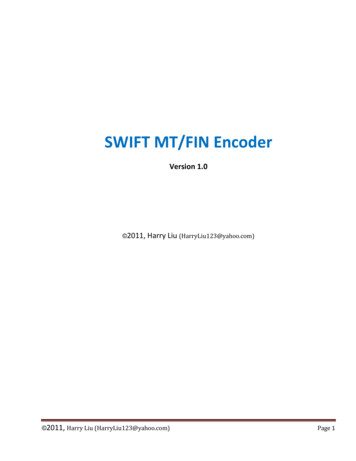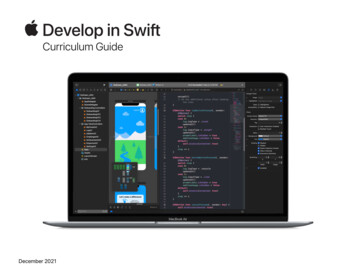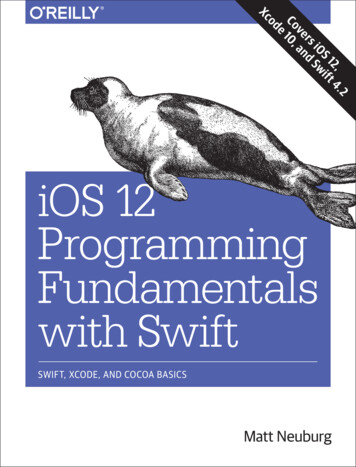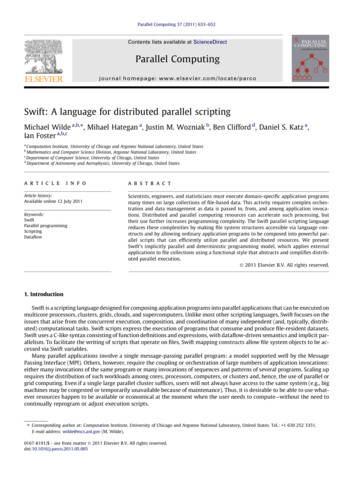
Transcription
Parallel Computing 37 (2011) 633–652Contents lists available at ScienceDirectParallel Computingjournal homepage: www.elsevier.com/locate/parcoSwift: A language for distributed parallel scriptingMichael Wilde a,b, , Mihael Hategan a, Justin M. Wozniak b, Ben Clifford d, Daniel S. Katz a,Ian Foster a,b,caComputation Institute, University of Chicago and Argonne National Laboratory, United StatesMathematics and Computer Science Division, Argonne National Laboratory, United StatescDepartment of Computer Science, University of Chicago, United StatesdDepartment of Astronomy and Astrophysics, University of Chicago, United Statesba r t i c l ei n f oArticle history:Available online 12 July 2011Keywords:SwiftParallel programmingScriptingDataflowa b s t r a c tScientists, engineers, and statisticians must execute domain-specific application programsmany times on large collections of file-based data. This activity requires complex orchestration and data management as data is passed to, from, and among application invocations. Distributed and parallel computing resources can accelerate such processing, buttheir use further increases programming complexity. The Swift parallel scripting languagereduces these complexities by making file system structures accessible via language constructs and by allowing ordinary application programs to be composed into powerful parallel scripts that can efficiently utilize parallel and distributed resources. We presentSwift’s implicitly parallel and deterministic programming model, which applies externalapplications to file collections using a functional style that abstracts and simplifies distributed parallel execution.Ó 2011 Elsevier B.V. All rights reserved.1. IntroductionSwift is a scripting language designed for composing application programs into parallel applications that can be executed onmulticore processors, clusters, grids, clouds, and supercomputers. Unlike most other scripting languages, Swift focuses on theissues that arise from the concurrent execution, composition, and coordination of many independent (and, typically, distributed) computational tasks. Swift scripts express the execution of programs that consume and produce file-resident datasets.Swift uses a C-like syntax consisting of function definitions and expressions, with dataflow-driven semantics and implicit parallelism. To facilitate the writing of scripts that operate on files, Swift mapping constructs allow file system objects to be accessed via Swift variables.Many parallel applications involve a single message-passing parallel program: a model supported well by the MessagePassing Interface (MPI). Others, however, require the coupling or orchestration of large numbers of application invocations:either many invocations of the same program or many invocations of sequences and patterns of several programs. Scaling uprequires the distribution of such workloads among cores, processors, computers, or clusters and, hence, the use of parallel orgrid computing. Even if a single large parallel cluster suffices, users will not always have access to the same system (e.g., bigmachines may be congested or temporarily unavailable because of maintenance). Thus, it is desirable to be able to use whatever resources happen to be available or economical at the moment when the user needs to compute—without the need tocontinually reprogram or adjust execution scripts. Corresponding author at: Computation Institute, University of Chicago and Argonne National Laboratory, United States. Tel.: 1 630 252 3351.E-mail address: wilde@mcs.anl.gov (M. Wilde).0167-8191/ - see front matter Ó 2011 Elsevier B.V. All rights reserved.doi:10.1016/j.parco.2011.05.005
634M. Wilde et al. / Parallel Computing 37 (2011) 633–652Swift’s primary value is that it provides a simple set of language constructs to specify how applications are glued togetherand executed in parallel at large scale. It regularizes and abstracts notions of processes and external data for distributed parallel execution of application programs.Swift is implicitly parallel and location-independent: the user does not explicitly code either parallel behavior or synchronization (or mutual exclusion) and does not code explicit transfer of files to and from execution sites. In fact, no knowledge ofruntime execution locations is directly specified in a Swift script. Swift’s functional model ensures that execution of Swiftscripts is deterministic (if the called functions are themselves deterministic), thus simplifying the scripting process. Havingthe results of a Swift script be independent of the way that its function invocations are parallelized implies that the functionsmust, for the same input, produce the same output, irrespective of the time, order, or location in which they are executed.However, Swift greatly simplifies the parallel scripting process even when this condition is not met.As a language, Swift is simpler than most scripting languages because it does not replicate the capabilities that scriptinglanguages such as Perl, Python, and shells do well; instead, Swift makes it easy to call such scripts as small applications.Swift can execute scripts that perform hundreds of thousands of program invocations on highly parallel resources and canhandle the unreliable and dynamic aspects of wide-area distributed resources. Such issues are managed by Swift’s runtimesystem and are not manifest in the user’s scripts. The number of processing units available on shared resources varies withtime. In order to take advantage of as many processing units as possible during the execution of a Swift program, flexibility isessential in the way the execution of individual processes is parallelized. Swift exploits the maximal concurrency permittedby data dependencies within a script and by external resource availability.Swift enables users to specify process composition by representing processes as functions, where input data files and process parameters become function parameters and output data files become function return values. Swift also provides ahigh-level representation of data collections (which can be used as function inputs and outputs) and a specification (‘‘mapper’’) that allows those collections to be processed by external programs. We chose to make the Swift language purely functional (i.e., all operations have a well-defined set of inputs and outputs, all variables are write-once, and no script-level sideeffects are permitted by the language) in order to prevent the difficulties that arise from having to track side effects to ensuredeterminism in complex concurrency scenarios. Functional programming allows consistent implementations of evaluationstrategies, in contrast to the more common approach of eager evaluation. This benefit has been similarly demonstrated inlazily evaluated languages such as Haskell [1].Swift uses the synchronization construct of futures [2] to enable automatic parallelization. Every Swift variable (includingall members of structures and arrays) is a future. Using a futures-based evaluation strategy allows for automatic parallelization without the need for dependency analysis. This significantly simplifies the Swift implementation.Other scripting languages do not adequately specify and encapsulate inputs to and outputs from a given application, suchthat an execution environment can automatically make remote execution transparent. Without this feature, achieving location transparency is not feasible. Swift adds to scripting what the remote procedure call (RPC) paradigm [3] adds to programming: by formalizing the inputs and outputs of applications that have been declared as Swift functions, it makes thedistributed remote execution of applications transparent.Swift has been described previously [4]; this paper goes into greater depth in describing the parallel aspects of the language, the way its implementation handles large-scale and distributed execution environments, and its contribution to distributed and parallel programming models.The remainder of this paper is organized as follows. Section 2 presents the fundamental concepts and language structuresof Swift. Section 3 details the Swift implementation, including the distributed architecture that enables applications to runon distributed resources. Section 4 describes real-world applications using Swift on scientific projects. Section 5 providesperformance results. Section 6 relates Swift to other systems. Section 7 highlights ongoing and future work in the Swift project. Section 8 offers concluding remarks about Swift’s distinguishing features and its role in scientific computing.2. The Swift languageSwift is, by design, a sparse scripting language that executes external programs remotely and in parallel. As such, Swifthas only a limited set of data types, operators, and built-in functions. Its data model comprises a few atomic types (that canbe scalar values or references to external files) and two collection types (arrays and structures).A Swift script uses a C-like syntax to describe data, application components, invocations of application components, andthe interrelations (data flow) among those invocations. Swift scripts are written as a set of functions, composed upwards,starting with atomic functions that specify the execution of external programs. Higher-level functions are then composedas pipelines (or, more generally, graphs) of subfunctions.Unlike most other scripting languages, Swift expresses invocations of ordinary programs—technically, POSIX exec ()operations—in a manner that explicitly declares the files and command-line arguments that are the inputs of each programinvocation. Swift scripts similarly declare all output files that result from program invocations. This approach enables Swiftto provide distributed, location-independent execution of external application programs.The Swift parallel execution model is based on two concepts that are applied uniformly throughout the language. First,every Swift data element behaves like a future. By ‘‘data element’’ we mean both the named variables within a function’senvironment, such as its local variables, parameters, and returns, and the individual elements of array and structure collec-
M. Wilde et al. / Parallel Computing 37 (2011) 633–652635tions. Second, all expressions in a Swift program are conceptually executed in parallel. Expressions (including function evaluations) wait for input values when they are required and then set their result values as their computation proceeds. Thesefundamental concepts of pervasive implicit parallelism and transparent location independence, along with the natural manner in which Swift expresses the processing of files by applications as if they were ‘‘in-memory’’ objects, are the powerfulaspects that make Swift unique among scripting tools. These aspects are elaborated in this section.2.1. Data model and typesVariables are used in Swift to name the local variables, arguments, and returns of a function. The outermost function in aSwift script (akin to ‘‘main’’ in C) is unique only in that the variables in its environment can be declared ‘‘global’’ to makethem accessible to every other function in the script.Each variable in a Swift script is declared to be of a specific type. The Swift type model is simple, with no concepts ofinheritance or abstraction. There are three basic classes of data types: primitive, mapped, and collection.The four primary primitive types are integer, float, string, and boolean. Common operators are defined for primitive types,such as arithmetic, concatenation, and explicit conversion. (An additional primitive type, ‘‘external,’’ is provided for manualsynchronization; we do not discuss this feature here.)Mapped types are used to declare data elements that refer (through a process called ‘‘mapping,’’ described in Section 2.5)to files external to the Swift script. These files can then be read and written by application programs called by Swift. Themapping process can map single variables to single files, and structures and arrays to collections of files. (For example,we might map the contents of a directory to a Swift array, D. We can then write ‘foreach f in D’ to operate on each filein the directory.) The language has no built-in mapped types. Instead, users declare mapped type names to specify genericor specific file types, as desired (for example, type file; type log;).A variable that is declared to be a mapped file is associated with a mapper, which defines (often through a dynamic lookupprocess) the file that is mapped to the variable.Mapped type and collection type variable declarations can be annotated with a mapping descriptor that specifies thefile(s) to be mapped to the Swift data element(s).For example, the following lines declare image to be a mapped file type and a variable named photo of type image. Sinceimage is a mapped file type, it additionally declares that the variable refers to a single file named shane.jpeg:type image { };image photo "shane.jpeg" ;The notation { } indicates that the type represents a reference to an external file, whose structure is opaque to the Swiftscript. For convenience such type declarations typically use the equivalent shorthand type image; (This compact notationcan be confusing at first but has become an accepted Swift idiom).The two collection types are structures and arrays. A structure type lists the set of elements contained in the structure, asfor example in the following definition of the structure type snapshot:type image;type metadata;type snapshot {metadata m;image i;}Members of a structure can be accessed by using the . operator:snapshot sn;image im;im sn.i;Structure fields can be of any type, whereas arrays contain values of only a single type. Both structures and arrays can containmembers of primitive, mapped, or collection types. In particular, arrays can be nested to provide multidimensional indexing.The size of a Swift array is not declared in the program but is determined at run time, as items are added to the array. Thisfeature proves useful for expressing some common classes of parallel computations. For example, we may create an arraycontaining just those experimental configurations that satisfy a certain criterion. An array is considered ‘‘closed’’ when nofurther statements that set an element of the array can be executed. This state is recognized at run time by information obtained from compile-time analysis of the script’s call graph. The set of elements that is thus defined need not be contiguous;in the words, the index set may be sparse. As we will demonstrate below, the foreach statement makes it easy to access allelements of an array.
636M. Wilde et al. / Parallel Computing 37 (2011) 633–6522.2. Built-in, application interface, and compound functionsSwift’s built-in functions are implemented by the Swift runtime system and perform various utility functions (numericconversion, string manipulation, etc.). Built-in operators ( , *, etc.) behave similarly.An application interface function (declared by using the app keyword) specifies both the interface (input files and parameters; output files) of an application program and the command-line syntax used to invoke the program. It thus provides theinformation that the Swift runtime system requires to invoke that program in a location-independent manner.For example, the following application interface defines a Swift function rotate that uses the common image processingutility convert [5] to rotate an image by a specified angle. The convert executable will be located at run time in a catalog ofapplications or through the PATH environment variable.app (image output) rotate (image input, int angle) {convert "-rotate" angle @input @output;}Having defined this function, we can now build a complete Swift script that rotates a file puppy.jpeg by 180 degrees togenerate the file rotated.jpeg:type image;image photo "puppy.jpeg" ;image rotated "rotated.jpeg" ;app (image output) rotate (image input, int angle) {convert "-rotate" angle @input @output;}rotated rotate (photo, 180);The last line in this script looks like an ordinary function invocation. However, due to the application interface functiondeclaration and the semantics of Swift, its execution in fact invokes the convert program, with variables on the left of theassignment bound to the output parameters and variables to the right of the function invocation passed as inputs.If we now store this script in a file called ‘example.swift’, we can invoke it from the command line, as follows, to execute a single convert command. ls *.jpegshane.jpeg swift example.swift. ls *.jpegshane.jpeg rotated.jpegA third class of Swift functions, the compound function, invokes other functions. For example, the following script defines acompound function process that invokes functions first and second. (A temporary file, intermediate, is used to connect the two functions. Since no mapping is specified, Swift generates a unique file name.)(file output) process (file input) {file intermediate;intermediate first (input);output second (intermediate);}This function is used in the following script to process a file x.txt, with output stored in file y.txt.file x "x.txt" ;file y "y.txt" ;y process (x);Compound functions can also contain flow-of-control statements (described below), while application interface functionscannot (since the latter serve to specify the functional interface for a single application invocation).
M. Wilde et al. / Parallel Computing 37 (2011) 633–6526372.3. Arrays and parallel executionArrays are declared by using the [] suffix. For example, we declare here an array containing three strings and then use theforeach construct to apply a function analyze to each element of that array. (The arguments fruit and index resolve tothe value of an array element and that element’s index, respectively.)string fruits[] {"apple", "pear", "orange"};file tastiness[];foreach fruit, index in fruits {tastiness[index] analyze (fruit);}The foreach construct is a principal means of expressing concurrency in Swift. The body of the foreach is executed inparallel for every element of the array specified by the in clause. In this example, all three invocations of the analyze function are invoked concurrently.2.4. Execution model: implicit parallelismWe have now described almost all of the Swift language. Swift also provides conditional execution through the if andswitch statements and explicit sequential iteration through the iterate statement. We do not elaborate on these featureshere, as they are less relevant to Swift’s parallel aspects.The Swift execution model is simple and uniform. Every data object is built up from atomic data elements that can beviewed as having three fields: a value, a state, and a queue of function invocations that are waiting for the value to be set.Swift data elements (atomic variables and array elements) are single-assignment. They can be assigned at most one valueduring execution, and they behave as futures. This semantic provides the basis for Swift’s model of parallel function evaluation and dependency chaining. While Swift collection types (arrays and structures) are not single-assignment, each of theirelements is single-assignment.Through the use of futures, functions become executable when their input parameters have all been set. Function callsmay be chained by passing an output variable of one function as the input variable to a second function. This data-drivenmodel means that Swift functions are not necessarily executed in source-code order but rather when their input data become available.Since all variables and collection elements are single-assignment, a function or expression can be executed when all of itsinput parameters have been assigned values. As a result of such execution, more variables may become assigned, possiblyallowing further parts of the script to execute. In this way, scripts are implicitly concurrent.For example, in the following script fragment, execution of functions p and q can occur in parallel:y p (x);z q (x);while in the next fragment, execution is serialized by the variable y, with function p executing before q:y p (x);z q (y);Note that reversing the order of these two statements in a script will not affect the order in which they are executed.Statements that deal with the array as a whole will wait for the array to be closed before executing. An example of such anaction is the expansion of the array values into an app function command line. Thus, the closing of an array is the equivalentto setting a future variable, with respect to any statement that was waiting for the array itself to be assigned a value. However, a foreach statement will apply its body of statements to elements of an array in a fully concurrent, pipelined manner,as they are set to a value. It will not wait until the array is closed. Such ’’pipelining’’ gives Swift a high degree of runtimeparallelism.For example, a foreach () statement that processes an array returned by a function may begin processing members ofthe returned array that have been already set, even before the entire function completes and returns.Consider the script below:file a[];file b[];foreach v,i in a {
638M. Wilde et al. / Parallel Computing 37 (2011) 633–652b[i] p (v);}a[0] r ();a[1] s ();Initially, the foreach statement will block, with nothing to execute, since the array a has not been assigned any values.At some point, in parallel, the functions r and s will execute. As soon as either is finished, the corresponding invocation offunction p will occur. After both r and s have completed, the array a will be regarded as closed, since no other statements inthe script make an assignment to a.2.5. Swift mappersSwift provides an extensible set of built-in mapping primitives (‘‘mappers’’) that make a given variable name refer to afilename. A mapper associated with a structured Swift variable can represent a large, structured data set. A representativeset of built-in mappers is listed in Table 1. Collections of files can be mapped to complex types (arrays and structures) byusing a variety of built-in mappers. For example, the following declarationfile frames[] filesys mapper; pattern "*.jpeg" ;foreach f,ix in frames {output[ix] rotate (f, 180);}uses the built-in filesys mapper to map all files matching the name pattern *.jpeg to an array–and then applies therotate function to each element of that array.Swift mappers can operate on files stored on the local machine in the directory where the swift command is executing,or they can map any files accessible to the local machine, using absolute pathnames. Custom mappers (and some of the builtin mappers) can also map variables to files specified by URIs for access from remote servers via protocols such as GridFTP orHTTP, as described in Section 3. Mappers can interact with structure fields and array elements in a simple and useful manner.New mappers can be added to Swift either as Java classes or as simple, external executable scripts or programs coded inany language. Mappers can operate both as input mappers (which map files to be processed as application inputs) and asoutput mappers (which specify the names of files to be produced by applications). It is important to understand that mapping a variable is a different operation from setting the value of a variable. Variables of mapped-file type are mapped (con-Table 1Example of selected built-in mappers showing their syntax and semantics.Mapper nameDescriptionsingle file mapperMaps single named fileExamplefile f \data:txt" ;——f ! data:txtfilesys mapperMaps directory contents into an arrayfile f½ filesys mapper;prefix ¼ \data";suffix ¼ \:txt" ;——f½0 ! data2:txtsimple mapperCan map fields of a structuremystruct s simple mapper;prefix ¼ \data:";suffix ¼ \:txt" ;——s:red ! data:red:txt
M. Wilde et al. / Parallel Computing 37 (2011) 633–652639ceptually) when the variable becomes ‘‘in scope,’’ but they are set when a statement assigns them a value. Mapper invocations (and invocations of external mapper executables) are completely synchronized with the Swift parallel execution model.This ability to abstract the processing of files by programs as if they were in-memory objects and to process them with animplicitly parallel programming model is Swift’s most valuable and noteworthy contribution.2.6. Swift application execution environmentA Swift app declaration describes how an application program is invoked. In order to provide a consistent execution environment that works for virtually all application programs, the environment in which programs are executed needs to be constrained with a set of conventions. The Swift execution model is based on the following assumptions: a program is invoked inits own working directory; in that working directory or one of its subdirectories, the program can expect to find all filespassed as inputs to the application block; and on exit, it should leave all files named by that application block in the sameworking directory.Applications should not assume that they will be executed on a particular host (to facilitate site portability), that they willrun in any particular order with respect to other application invocations in a script (except those implied by data dependency), or that their working directories will or will not be cleaned up after execution. In addition, applications should striveto avoid side effects that could limit both their location independence and the determinism of Swift scripts that call them.Consider the following app declaration for the rotate function:app (file output) rotate (file input, int angle)The function signature declares the inputs and outputs for this function. As in many other programming languages, this declaration defines the type signatures and names of parameters; this also defines which files will be placed in the applicationworking directory before execution and which files will be expected there after execution. For the above declaration, the filemapped to the input parameter will be placed in the working directory beforehand, and the file mapped to output will beexpected there after execution; since the input parameter angle is of primitive type, no files are staged in for this parameter.The body of the app block defines the command line that will be executed when the function is invoked:convert "-rotate" angle @input @output;The first token (in this case convert) defines a application name that is used to locate the executable program. Subsequent expressions define the command-line arguments for that executable: ‘‘-rotate’’ is a string literal; angle specifiesthe value of the angle parameter; and the syntax @variable (shorthand for the built-in function @filename ()) evaluatesto the filename of the supplied variable. Thus @input and @output insert the filenames of the corresponding parametersinto the command line. We note that the filename of output can be taken even though it is a return parameter; althoughthe value of that variable has not yet been computed, the filename to be used for that value is already available from themapper.3. The Swift runtime environmentThe Swift runtime environment comprises a set of services providing the parallel, distributed, and reliable execution thatunderlie the Swift language model. A key contribution of Swift is the extent to which the language model has been kept simple by factoring the complexity of these issues out of the language and implementing them in the runtime environment.Notable features of this environment include the following: Location-transparent execution: automatic selection of a location for each program invocation and management ofdiverse execution environments. A Swift script can be tested on a single local workstation. The same script then canbe executed on a cluster, one or more grids of clusters, or a large-scale parallel supercomputer such as the Sun Constellation [6] or the IBM Blue Gene/P [7]. Automatic parallelization of application program invocations that have no data dependencies. The pervasive implicit parallelism inherent in a Swift script is made practical through various throttling and scheduling semantics of the runtimeenvironment. Automatic balancing of work over available resources, based on adaptive algorithms that account for both resource performance and reliability and that throttle program invocations at a rate appropriate for each execution location andmechanism. Reliability, through automated replication of application invocations, automatic resubmission of failed invocations, andthe ability to continue execution of interrupted scripts from the point of failure. Formalizing of the creation and management of data objects in the language and recording of the provenance of dataobjects produced by a Swift script.
640M. Wilde et al. / Parallel Computing 37 (2011) 633–652Swift is implemented by generating and executing a Karajan program [8], which provides several benefits: a lightweightthreading model, futures, remote job execution, and remote file transfer and data management. Both remote execution anddata transfer and management functions are provided through abstract interfaces called providers [8]. Data providers enabledata transfer and management to be performed through a wide variety of protocols including direct local copying, GridFTP,HTTP, WebDAV, SCP, and FTP. Execution providers enable job execution to take place by using direct POSIX process fork, Globus GRAM, Condor (and Condor-G), PBS, SGE, and SSH services. The Swift execution model can be extended to new computing environments by implementing new data providers and/or job execution providers.3.1. Executing on a remote siteGiven Swift’s pragmatically constrained model of application invocation and file passing, execution of a program on a remote site is straightforward. The Swift runtime system must prepare a remote working directory for each job with appropriate input files staged in;
Swift: A language for distributed parallel scripting Michael Wildea,b, , Mihael Hategana, Justin M. Wozniakb, Ben Cliffordd, Daniel S. Katza, Ian Fostera,b,c a Computation Institute, University of Chicago and Argonne National Laboratory, United States bMathematics and Computer Science Division, Argonne National Lab

